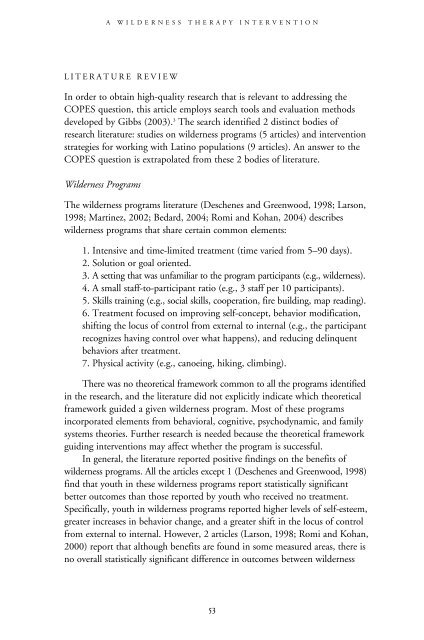2006 - School of Social Service Administration - University of Chicago
2006 - School of Social Service Administration - University of Chicago
2006 - School of Social Service Administration - University of Chicago
Create successful ePaper yourself
Turn your PDF publications into a flip-book with our unique Google optimized e-Paper software.
A WILDERNESS THERAPY INTERVENTION<br />
LITERATURE REVIEW<br />
In order to obtain high-quality research that is relevant to addressing the<br />
COPES question, this article employs search tools and evaluation methods<br />
developed by Gibbs (2003). 3 The search identified 2 distinct bodies <strong>of</strong><br />
research literature: studies on wilderness programs (5 articles) and intervention<br />
strategies for working with Latino populations (9 articles). An answer to the<br />
COPES question is extrapolated from these 2 bodies <strong>of</strong> literature.<br />
Wilderness Programs<br />
The wilderness programs literature (Deschenes and Greenwood, 1998; Larson,<br />
1998; Martinez, 2002; Bedard, 2004; Romi and Kohan, 2004) describes<br />
wilderness programs that share certain common elements:<br />
1. Intensive and time-limited treatment (time varied from 5–90 days).<br />
2. Solution or goal oriented.<br />
3. A setting that was unfamiliar to the program participants (e.g., wilderness).<br />
4. A small staff-to-participant ratio (e.g., 3 staff per 10 participants).<br />
5. Skills training (e.g., social skills, cooperation, fire building, map reading).<br />
6. Treatment focused on improving self-concept, behavior modification,<br />
shifting the locus <strong>of</strong> control from external to internal (e.g., the participant<br />
recognizes having control over what happens), and reducing delinquent<br />
behaviors after treatment.<br />
7. Physical activity (e.g., canoeing, hiking, climbing).<br />
There was no theoretical framework common to all the programs identified<br />
in the research, and the literature did not explicitly indicate which theoretical<br />
framework guided a given wilderness program. Most <strong>of</strong> these programs<br />
incorporated elements from behavioral, cognitive, psychodynamic, and family<br />
systems theories. Further research is needed because the theoretical framework<br />
guiding interventions may affect whether the program is successful.<br />
In general, the literature reported positive findings on the benefits <strong>of</strong><br />
wilderness programs. All the articles except 1 (Deschenes and Greenwood, 1998)<br />
find that youth in these wilderness programs report statistically significant<br />
better outcomes than those reported by youth who received no treatment.<br />
Specifically, youth in wilderness programs reported higher levels <strong>of</strong> self-esteem,<br />
greater increases in behavior change, and a greater shift in the locus <strong>of</strong> control<br />
from external to internal. However, 2 articles (Larson, 1998; Romi and Kohan,<br />
2000) report that although benefits are found in some measured areas, there is<br />
no overall statistically significant difference in outcomes between wilderness<br />
53
















